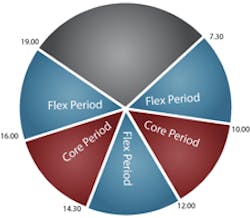Web-Exclusive Feature: Flexible Working Enhances Job Control, Employee Well-Being
Instead of holding all employees to a set 9-5 workday, many companies are exploring other, more flexible options made available by technological advances. Such arrangements can including working from home or on the road, job sharing, term-time working (working longer hours in school terms while taking time off during the summer), compressed workweeks and more.
But don’t confuse "flexible" with "anything goes." Flexible working actually is a structured system with vital ground rules. For example, FlexTime divides workdays into the following four timeframes to replace traditional, 9-5 work arrangements with a more flexible option:
· The Bandwidth timeframe includes the earliest and latest times in a day that employees can record and accrue time – say, from 7:00 a.m. to 7:00 p.m.
· Core Time is the main part of the day when everyone must be in attendance.
· Flexible Time encompasses the beginning and end of the day, and often lunchtime, when staff can choose their hours of arrival and departure (within the constraints of agreed-upon rules).
· Flex Days can allow employees who have accrued extra hours over the cycle to take half or full days off.
These times periods are arranged into a cycle of days in the agreed flex period. Often, the set cycle lasts one month, but companies can opt for longer or shorter periods. Companies also designate a carry forward allowance – the amount of time, often one day, that can be accrued during the cycle.
The Benefits of Flexible Work
FlexTime turned to research to consider the psychology of what leads to well-being in the workplace. The company's job control study with City University London involved over 1,000 users of FlexTime's system. After accepting that many earlier studies had found that flexible working can lead to reductions in absenteeism, employee turnover and overtime, FlexTime focused on why such reductions happen.
The research revealed two key findings: 1) flexible working offers the employee a greater control over his/her job and 2) employees respond favorably if provided with a greater control over their jobs.
In addition, research suggests that job control predicts lower stress-related outcomes – both in the psychological sense (e.g. anxiety, burnout) as well as with physical symptoms (e.g. coronary heart disease). Other evidence also shows that job control predicts job satisfaction.
To keep employees motivated, happy and productive, companies should ask the following questions about their current working environments:
· Management Style – Does our approach suit the changed economy that we are now living in?
· Uncertainty – We often already come into work each day from an uncertain world outside. Are we doing enough to make sure that our workplace policies can ease that uncertainty?
· Conditions – With pay reductions and other cuts happening regularly across the work force, are we doing enough to ensure that such negative financial and motivational outcomes for employees are counter balanced?
Flexible working arrangements are relatively easy to implement and to retain. Introducing flexible working can lead to an improved work/life balance, and happy employees often are productive employees. So maybe you should reconsider how you allow working time to be managed in the future. After all, it's about time!
Ciaran Rowsome is CEO at FlexTime Limited. Since 1983, he has focused on the subject of flexible working and has assisted hundreds of public and private organizations in implementing these concepts. For more information, visit http://www.flextime.ie/about-us.
